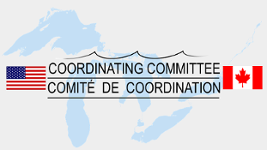The Coordinating Committee is responsible for the coordination of the collection, compilation, use, and dissemination of data related to hydraulics, hydrology, and vertical control for the Great Lakes – St. Lawrence River System. A fundamental requirement for coordinated management is a common height reference system or “vertical datum” by which water levels can be measured and meaningfully related to each other.
The first such vertical datum for the Great Lakes was the International Great Lakes Datum of 1955 (IGLD (1955)). To ensure the vertical datum provides sufficiently accurate heights, it must be adjusted approximately every 30-35 years to account for the effects of glacial isostatic adjustment (GIA) since the last ice age. GIA is Earth’s continuing response to the loss of weight of the ice sheets, where areas that were under the ice are rebounding and areas outside the periphery of the ice sheets are subsiding.
IGLD (1955) was updated to IGLD (1985) to account for GIA and, 35 years later, the Coordinating Committee is once again updating IGLD. The Committee’s Vertical Control – Water Levels Subcommittee is overseeing this work and has developed a comprehensive plan.
Full Plan
Download the Full Plan – an updated version of this plan is under development
Executive Summary
The Great Lakes – St. Lawrence River system is one of the world’s greatest freshwater resources and has important environmental, cultural, and economic value for Canada and the United States. The Great Lakes have long been an economic driver for both nations ($180 billion in Canada-U.S. trade). An analysis found that more than 1.5 million jobs are directly connected to the Great Lakes, generating $62 billion in annual wages. The Midwest has recently suffered economic hardships but, thanks to the Great Lakes, the region still generated 27% of the U.S. gross domestic product and 24% of the country’s exports in 2009. It is estimated that marine shipping on the Great Lakes moves 164 million metric tons of essential raw materials and finished products annually. A slight decrease in the depth of a waterway means that a vessel must decrease its draft (i.e., reduce the amount of cargo that it’s carrying). The Great Lakes Information Network estimates that a 1,000-foot vessel will need to reduce its cargo by about 270 tons for each inch decrease in its draft (a 300-m vessel needs to reduce its cargo by 100 tons for each centimeter decrease in draft).
Use of Great Lakes freshwater resources by the people of Canada, the United States, First Nations and Native Americans, requires knowledge and measurement of water levels, depths, volumes and flows throughout the region. The joint, harmonious use of these waters requires international coordination of many aspects of their management. The Coordinating Committee on Great Lakes Basic Hydraulic and Hydrologic Data (Coordinating Committee) is an ad hoc committee of experts from Federal agencies of the United States and Canada that is responsible for coordinating the collection, compilation, use, and dissemination of data related to hydraulics, hydrology, vertical control and water levels for the Great Lakes – St. Lawrence River System. A fundamental requirement for coordinated management is a common height reference system or “vertical datum” by which water levels can be measured and meaningfully related to each other. The first such common datum was the International Great Lakes Datum of 1955 (IGLD (1955)), later updated to IGLD (1985). To ensure that the vertical datum can provide sufficiently accurate heights, it must be adjusted every 25-30 years to account for the effects of glacial isostatic adjustment (GIA) described below.
Presently the Coordinating Committee is undertaking the development of the next IGLD, referred to here as IGLD (2020). This document outlines the scope of work involved. The Vertical Control-Water Levels Subcommittee of the Coordinating Committee is overseeing this important work. Unlike the previous two IGLDs, this datum update will use a geoid-based vertical datum that will be accessible using global navigation satellite systems (GNSS) such as the Global Positioning System (GPS). The same GNSS used for diverse applications that include navigation of ships, aircraft, spacecraft, and ground vehicles, is employed to monitor millimeter-level shifts of the Earth’s surface. GNSS technology will also provide the capability for millimeter-level measurements of water levels in support of safe navigation, regulation, lake level forecasting, international cooperative treaties and agreements, riparian interests, hydroelectric power generation, construction, dredging, litigation, and many other environmental, water resources management and development activities. The water level datum (IGLD) and gauge infrastructure are key components to both nations’ transportation and logistics network information. A reliable port and inland waterway system ensures that commercial goods can move quickly, affordably, and safely to facilitate trade and benefit the economies of both countries.
PPT File
- 2017 PowerPoint Download
 Great Lakes Coordinating Committee
Great Lakes Coordinating Committee